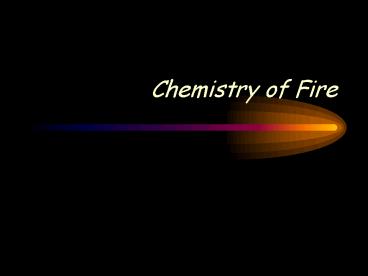Chemistry of Fire - PowerPoint PPT Presentation
1 / 12
Title:
Chemistry of Fire
Description:
Energy in chemical reaction comes from the breaking and formation of bonds. Heat of combustion ... Detonation The speed at which explosives decompose ... – PowerPoint PPT presentation
Number of Views:475
Avg rating:3.0/5.0
Title: Chemistry of Fire
1
Chemistry of Fire
2
What is fire?
- Answer Fire is heat and light from rapid
combination of oxygen and other materials. - For fire to exist, a combustible substance must
be present, the temperature must be high enough
to cause combustion, and enough oxygen must be
present to sustain rapid combustion.
3
Chemistry of Fire
- Oxygen combines with other substances to produce
new products oxidation - CH4 2O2 ? CO2 2H2O
- Stored chemical energy converted to energy in the
form of heat and light. - Energy in chemical reaction comes from the
breaking and formation of bonds.
4
- Heat of combustion exothermic
- Activation energy needed to start the combustion
ignition temperature - Ignition Temperature Minimum temperature at
which a fuel will spontaneously ignite. - Fire continues to burn until the supply of oxygen
is exhausted or fuel is gone
5
- Activation energy the minimum energy necessary
for a specific chemical reaction to occur i.e.
matches, electrical discharges, sparks, and
chemicals. - Fuel needs to be in gaseous state to ignite
temperature must be high enough to vaporize the
fuel.
6
- Spontaneous Combustion is a type of combustion
which occurs without an external ignition source.
- Heat builds up to the point of ignition
- Use chemicals to supply oxygen oxidizing agents
7
Requirements for Combustion
- A fuel must be present
- Oxygen must be available in sufficient quantity
- Heat must be applied to initiate combustion, and
sufficient heat must be generated to sustain the
reaction. - Rate of oxidation (reaction) Rate of oxidation
of a fuel must be capable of sustaining a
flaming fire.
8
- Flash Point Minimum temperature at which a
liquid fuel will produce enough vapor to burn. - Flammable Range The (range of) composition of
fuel-air mixture required for combustion. - Flammable range of gasoline is 1.3- 6.
9
Detonation
- The speed at which explosives decompose
(detonation) varies greatly and permits the
classification of explosives as high and low
explosives. - Low Explosives Low explosives have velocities
of detonation less than 1,000 m/s. - Black powder (KNO3CarbonSulfur751510)
Merely burns when unconfined, used as safety fuse
because of its low rate of detonation (rate of
deflagration)
10
- High Explosives classify high explosives as
primary and secondary explosives . - Primary explosives are very sensitive to heat and
shock and will detonate violently (not burn). - Lead azide and diazodinitrophenol are examples of
Primary explosives. - TNT is an example of a secondary explosive.
11
Difficult to Analyze Arson
- These crimes are carried out at the convenience
of the perpetrator and are often "well-planned"
to hide crucial evidences - Inability to collect crucial/useful evidence due
to the accompanied destruction of the crime scene
- (iii) volatile evidences are hard to collect and
preserve.
12
Searching the Fire Scence
- Must be done soon after the suspected fire.
- Determine fire's origin (use of streamers to
ignite multiple points at the same time) - Normally, a fire has a tendency to move in an
upward direction. The origin of the fire may be
closest to the lowest point that show the most
intense characteristic of burning. (weather
condition will alter the normal progression of
fire) - GC-MS is the analytical method of choice































